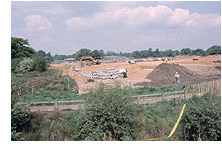|  This
paper provides an analysis of the impact of the construction and
development sector upon the delivery of nature conservation objectives
in England. In this context, the construction and development
sector is defined as including planners, developers, clients,
designers, contractors and professional bodies involved in the
development, design and/or construction of domestic, commercial
and industrial premises, and of civil engineering infrastructure. This
paper provides an analysis of the impact of the construction and
development sector upon the delivery of nature conservation objectives
in England. In this context, the construction and development
sector is defined as including planners, developers, clients,
designers, contractors and professional bodies involved in the
development, design and/or construction of domestic, commercial
and industrial premises, and of civil engineering infrastructure.
It examines the key socio-economic and political factors that
shape the construction and development sector, including DTI and
ODPM initiatives, for example the reform of the planning system,
implementation of the sustainable construction strategy and industry-based
initiatives such as the Construction Industry Environmental Forum
(CIEF).
It describes the roles of the key players within the sector,
including ODPM?s Planning Directorate, DTI's Construction Directorate,
the distinctive place of large and small companies and the role
of representative umbrella organisations (such as the House Builders
Federation and the Construction Confederation).
The paper analyses the nature conservation impacts of the construction
and development sector, both positive and negative. These are
wide-ranging and significant, including both the direct loss of
land of nature conservation value and numerous indirect negative
effects on sites and features of importance. It also highlights
opportunities for enhancement and the creation of new wildlife
habitats.
|

